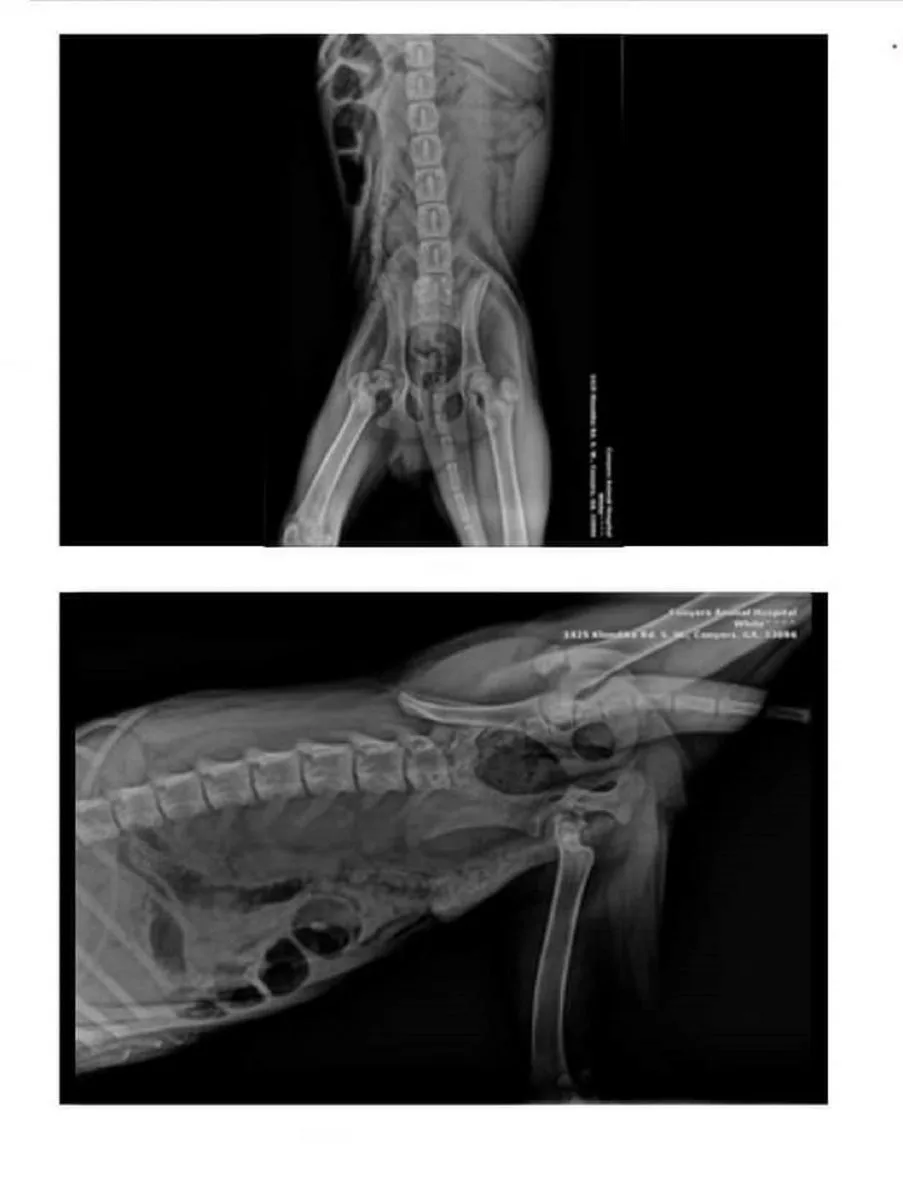Finding a terrified, malnourished puppy in the middle of nowhere is a nightmare for any dog lover, especially if it’s a helpless puppy that still has no idea how to take care of himself.
A pittie named Hank was abandoned in the woods at just eight months of age. I’m not sure whether his owners tried to clear their consciousness by leaving Hank with his belongings and an unsealed food bag (that he couldn’t open by himself), but they failed either way.
However, thanks to the good people who still exist in this world, Hank’s story has a happy ending.
Hank, The Living Dog Statue

A Good Samaritan accidentally came across a puppy in a local forest in Florida. The doggo was sitting still on his dog bed, without making any kind of movement, even when the unknown rescuer came closer to him.
The man noticed a bag of dog food next to the pup and some toys, which his previous owners must have left with him. However, the bag was unopened, and it was practically impossible for the dog to open it by himself.
What worried the rescuer the most was that the pooch was completely unresponsive to any type of communication – he was just sitting there like a real living statue.
Although the man had no idea where the pup came from or who left him there, there was one thing he knew by the look on the poor pup’s face – his heart was shattered into pieces.
Considering the state of the dog and his unresponsiveness, the man decided not to move him, but called a local animal shelter to pick him up instead.

A Ray Of Hope
After two weeks in the woods, Hank finally received help from the shelter staff who immediately responded to the call.
They approached him with caution, as they feared Hank might become hostile towards humans because of the situation he was in. However, as soon as they got to him, Hank showed nothing but gratitude and affection towards his saviors.
Rosa Fond, the owner of Humans and Animals United, told The Dodo that Hank was one of the cutest and most loving dogs they had ever seen, which is why he soon got under the skin of all the staff at the shelter.

He knew that the hoomans who approached him were there to rescue him, which is why he tried to show how thankful he was for their act of kindness.
The ‘Living Statue’ Mystery Solved
After a vet examination, it was finally clear why the pup wasn’t moving when the Good Samaritan and shelter staff approached him – he had a broken leg.

The vet believed that the leg injury was at least two weeks old, which means that he might have gotten it even before he was abandoned. There were no other visible signs of violence, so it’s not clear whether the dog was abused before being left in the forest.
One thing was sure – Hank needed leg surgery as soon as possible, and Fond didn’t think twice about covering all the costs of the treatment.
But, Hank wasn’t a good candidate for the surgery, as he was malnourished, so they had to wait a bit more until he gained some weight.

In the meantime, the doggo received lots of hugs, kisses, and cuddles from the vet staff who just couldn’t get enough of him.
After the surgery, Hank was placed into a foster home where he’s spending the best days of his life.

Although there were a lot of inquiries regarding the adoption of this wonderful doggo, Fond thinks it would be better for him to completely recover before being placed into a new family.
“He’s gonna have a little bit of a journey to go through before he’s fully adoptable […] But, he’s safe now and he’ll never, ever be hurt again.”
If you’ve noticed your furry friend peeing blood, it can be a concerning sight. As a seasoned dog enthusiast, you understand the importance of your pup’s health and well-being. Seeing blood in your dog’s urine can raise alarms and leave you wondering about the underlying cause. It’s vital to address this issue promptly to ensure your canine companion’s health is in top shape.
As a dog owner, witnessing unusual symptoms like bloody urine can be distressing. Your pup relies on you to take care of them, and understanding the reasons behind this concerning issue is crucial. In this article, we’ll shed light on the potential reasons why your dog might be peeing blood, helping you navigate this worrisome situation with confidence.
Understanding Hematuria: What Does It Mean When Your Dog Pees Blood?
The Basics of Hematuria in Dogs
Hematuria is the veterinary term for blood in the urine, which can be a distressing symptom for dog owners. When you notice your dog peeing blood, it’s crucial to understand that this is not normal and requires prompt attention. Hematuria can indicate various underlying issues, ranging from mild to severe conditions affecting your dog’s health.
Recognizing the Signs Beyond Blood in Urine
Apart from visible blood in your dog’s urine, there are other signs that may accompany hematuria. Keep an eye out for additional symptoms such as increased or decreased urination frequency, straining to urinate, changes in urine color, unusual odors, or signs of discomfort when urinating. These additional signs can provide valuable clues to help your veterinarian diagnose the underlying cause of your dog’s hematuria.
Common Causes of Blood in a Dog’s Urine
Urinary Tract Infections and Stones
Urinary tract infections (UTIs) are a common cause of blood in a dog’s urine. These infections can lead to irritation and inflammation in the urinary tract, resulting in blood being present in the urine. Similarly, stones in the urinary tract can cause bleeding, leading to blood in your dog’s urine. If you notice your dog peeing blood along with other symptoms like frequent urination or straining, a UTI or stones could be the culprit.
Trauma to the Urinary System
Trauma to the urinary system, caused by accidents, injuries, or even rough play, can result in blood in your dog’s urine. Blunt force trauma or injuries to the lower abdomen can lead to internal bleeding, which may be visible in their urine. If your dog has been involved in any such incidents and is showing signs of blood in their urine, it’s essential to consult your veterinarian for a thorough evaluation.
Poisoning and Toxins
Ingestion of toxic substances or poisoning can also manifest as blood in a dog’s urine. Certain chemicals, plants, or medications can harm your dog’s urinary system, causing bleeding in their urine. If you suspect that your dog has been exposed to any toxins and you observe blood in their urine, seek immediate veterinary care to address the poisoning and prevent further complications.
Serious Medical Conditions
Blood in a dog’s urine can be indicative of more severe underlying medical conditions such as cancer, clotting disorders, or kidney disease. These conditions require prompt attention and proper diagnosis by a veterinarian. If you notice consistent blood in your dog’s urine or other concerning symptoms like lethargy or loss of appetite, it’s crucial to seek professional medical advice to identify and address any potential serious medical issues promptly.
Diagnostic Steps to Determine the Cause
Veterinary Physical Examinations
When your dog is peeing blood, the first step is a thorough physical exam by a vet. They will palpate the abdomen, check for signs of pain or discomfort, and assess your dog’s overall health. The vet may also look for any visible abnormalities that could indicate the cause of hematuria.
Urine Tests and Imaging
Urine tests are crucial to determine the underlying cause of blood in your dog’s pee. A urinalysis can reveal the presence of blood, bacteria, or crystals in the urine. Imaging techniques such as X-rays or ultrasounds may be recommended to assess the urinary tract, bladder, and kidneys for any abnormalities or stones that could be causing the hematuria.
Additional Diagnostic Procedures
In some cases, additional diagnostic procedures like blood tests, cystoscopy, or biopsy may be necessary to pinpoint the exact cause of blood in your dog’s urine. These procedures provide detailed insights into your dog’s health condition, helping the vet formulate an accurate diagnosis and determine the most appropriate treatment plan.
Treatment Options for Dogs with Hematuria
Treating Infections and Stones
When it comes to handling infections and stones causing hematuria in your furry friend, the primary approach usually involves antibiotics for infections and dietary management or surgical intervention for stones. Antibiotics prescribed by your vet can help clear up infections, while specific diets or surgical procedures are recommended to dissolve or remove stones from your dog’s urinary tract.
Surgical Interventions
In cases where infections or stones are severe or recurrent, surgical interventions may be necessary. Your veterinarian might suggest procedures such as cystotomy to remove bladder stones or even nephrectomy if a kidney is severely affected. Surgical interventions aim to alleviate the underlying issue causing hematuria and improve your dog’s urinary health in the long run.
Long-Term Management and Care
After initial treatment, ensuring long-term management and care is crucial to prevent a recurrence of hematuria in your dog. This may involve following a specific diet recommended by your vet to prevent stone formation, providing ample water for hydration, regular vet check-ups to monitor urinary health, and maintaining overall well-being through exercise and a healthy lifestyle. Taking proactive steps in managing your dog’s health can help prevent future episodes of hematuria and maintain their quality of life.
How to Care for a Dog with Urinary Issues
Diet and Nutrition Strategies
When caring for a dog with urinary issues, it’s vital to focus on their diet and nutrition. Opt for a high-quality, balanced dog food that supports urinary health. Look for options low in additives and fillers, as these can aggravate urinary problems. Additionally, consider consulting your vet for specialized diets aimed at addressing specific urinary conditions.
Encouraging Water Intake and Regular Bathroom Breaks
Encouraging your dog to drink plenty of water is key to maintaining urinary tract health. Ensure fresh water is always available, and consider incorporating wet food into their diet for added hydration. Take your dog out for regular bathroom breaks to prevent urine stagnation, which can contribute to urinary issues.
Monitoring Your Dog’s Symptoms
Regular monitoring of your dog’s symptoms is crucial in managing urinary issues. Keep an eye out for changes in urination frequency, color, and any signs of discomfort. If you notice blood in their urine or they struggle to urinate, seek veterinary attention immediately. Monitoring their symptoms can help catch potential problems early and prevent complications.
Prevention Tips for Keeping Your Dog’s Urinary Tract Healthy
Regular Veterinary Check-Ups
Having your dog go for regular check-ups with the vet is crucial to monitor their urinary tract health. Your vet can detect any potential issues early on, allowing for timely intervention and treatment. Schedule these check-ups at least once a year, or more frequently if your dog has a history of urinary problems.
Preventive Health Measures
Maintaining your dog’s overall health is key to preventing urinary tract issues. Ensure your pup stays hydrated by always providing fresh water. A balanced diet that meets their nutritional needs is essential. Regular exercise helps keep your dog at a healthy weight, reducing the risk of urinary complications. Pay attention to any changes in your dog’s urination habits and seek veterinary advice if you notice anything concerning.
Remember, proactive care and regular monitoring of your dog’s urinary health can go a long way in keeping them happy and healthy.
Conclusion
So, there you have it – understanding why your dog is peeing blood is crucial. Remember, timely action is key in addressing this issue. By recognizing the signs, getting prompt veterinary help, and following through with the necessary tests and treatments, you can help your furry friend get back on track to a healthier and happier life. Keep an eye out for any changes in behavior or symptoms, stick to the treatment plan provided by your vet, and focus on preventive measures to avoid future episodes. Your dog’s well-being is in your hands, so stay informed, stay proactive, and give them the care and attention they deserve.
Frequently Asked Questions
What is hematuria in dogs?
Hematuria in dogs refers to the presence of blood in the urine, indicating potential underlying health issues such as infections, stones, trauma, poisoning, cancer, or kidney disease.
How is hematuria diagnosed in dogs?
Diagnosis involves physical exams, urine tests, imaging studies, and potentially blood tests or biopsies to determine the cause of hematuria in dogs.
What are the treatment options for hematuria in dogs?
Treatment may include antibiotics for infections, dietary management, or surgical interventions like cystotomy or nephrectomy for severe cases of hematuria in dogs.
How can I care for a dog with urinary issues?
Care involves maintaining a specific diet, encouraging water intake, regular bathroom breaks, and monitoring symptoms closely for early detection of potential problems in dogs.
What are some tips for preventing urinary issues in dogs?
Prevention includes regular veterinary check-ups, ensuring hydration, providing a balanced diet, regular exercise, and proactive care and monitoring to safeguard a dog’s urinary tract health.
[no_toc]

Hey there, I’m Janet Brooks, a dog-loving student from California. I’m all about helping pups in need, especially those without homes. Me and my awesome friends work together to give shelter and love to stray dogs. Oh, and I also write blogs about dogs to share helpful info.